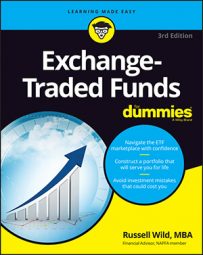The two oldest and most popular ETFs that use social screens are as different as night and day. The iShares MSCI USA ESG Select Index ETF (KLD) is a broad-based large cap blend (both value and growth) fund. The PowerShares WilderHill Clean Energy Fund (PBW) is a narrow industry sector fund and a small growth style fund and a bit global with approximately 25 percent of the holdings being non-U.S.
iShares MSCI USA ESG Select Index ETF (KLD)
Indexed to: The MSCI USA ESG Select Social Index (ESG stands for environment, social, and governance). The index starts with 250 or so fairly large U.S. corporations. Based on each company’s record for social justice and environmental performance, it overweights purportedly ethical companies and underweights supposedly unethical ones while making sure that all industries other than tobacco are represented.
Expense ratio: 0.50 percent
Top five companies: Eaton Corp.; International Business Machines; Starbucks; Johnson & Johnson; Becton, Dickinson and Company
Top five industries: Information technology, healthcare, consumer discretionary, consumer staples, financials
PowerShares WilderHill Clean Energy Fund (PBW)
Indexed to: The WilderHill Clean Energy Index, which tracks three dozen companies that invest in solar energy, windmills, hydrogen fuel cells, rechargeable batteries, and other forms of environmentally friendly power
Expense ratio: 0.70 percent
Top five companies (most of which you’ve probably never heard of): GT Solar, Tesla Motors, Sociedad Qumica y Minera de Chile, OM Group, SunPower Corp.
Top five countries: United States, China, Canada, Brazil, Germany
These two funds are very different from each other. KLD covers a large swath of the market, while PBW is more narrowly focused. Both funds cost less than half of what the average socially conscious mutual fund would cost; that is certainly a good thing.
On the other hand, SRI ETFs charge considerably more than many other ETFs. (The average expense ratio for the entire SRI category is about 0.70 percent, whereas many ETFs carry expense ratios of 0.20 percent or less.)
Keep in mind that SRI ETF providers don’t offer or promise the same kind of shareholder activism that you get with some of the more aggressive mutual fund companies. That’s because most mutual funds are more actively managed than ETFs. Passive management is part of what makes ETFs so appealing because it leads to lower management fees and greater transparency.
However, active management — such as that found with many mutual funds — may help keep an SRI fund more closely aligned with its stated values. Depending on the level of activism you’d like to see in your SRI fund company, this fact may lessen the appeal of pursuing socially responsible investing via ETFs.
KLD is quite liberal in its definition of “socially responsible” (not in the political sense but in the ease with which a stock can survive its screen). The fund makes many compromises in its selection of stocks. Certain socially conscious mutual funds have much tougher screening criteria than KLD does.
In terms of diversification, some prefer to see large cap stocks split distinctly into value and growth. With the SRI ETFs, however, you get a mushier exposure to these large cap categories. Looking through the lens of diversification, PBW offers up a small sliver of the economy and, as such, can involve considerable risk.
On the other hand, all energy stocks — both clean and dirty — have lately shown a delightful lack of correlation to the market as a whole.
If you want to invest for a better world and a better portfolio, you should do additional research. One person’s idea of socially responsible may be very different than another’s. What works for one portfolio may not work for another. There’s a ton of information on the website of the Forum for Sustainable and Responsible Investment.

